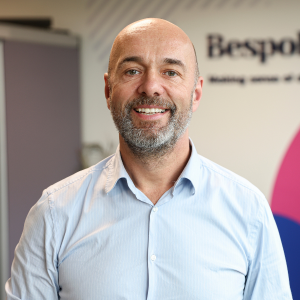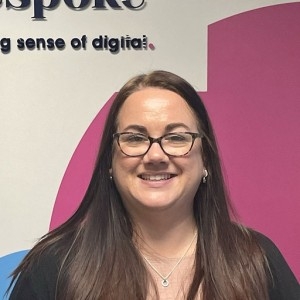
4 minutes
The foundation of a successful website lies in its structure.
In this video, Phil & Laura discuss creating a website structure that works for your customers. Drawing on insights from over 250 website projects delivered since 2001, they explain how workshops, high-impact search terms, and user-first journeys form the backbone of a high-performing website.
These takeaways will help you create a structure that drives high-value traffic, engages visitors, and converts them into leads.
Phil: So Laura, here at Bespoke we've been developing successful website projects for over 23 years now, and in that time, we've done over 250. Could you just talk to me about some of the successful components that go into creating a successful website structure?
Laura: We start off with a workshop to draw out all the objectives from the client and what the site needs to do, what we want the users to do once they land on the site, so we always start off with that. It's really important to identify high impact search terms so that we can bring in the high value traffic once the website's live and it's really specifically about the user journey. So it needs to be simple, it needs to be clear, and it needs to be clear what we want them to do on the website so that the user journey is nice and simple.
Phil: So having done many, many projects over time, could you give me a sort of a key insight that we've learnt that's really valuable, that may not beobvious?
Laura: I think it's really important when we do the workshops that the clients come toward us; they get away from the desks. It's really difficult to plan the best structure for your website when you’re just huddled around a desk in your normal office. So we get them out we get them to take a zoomed out look at the overall project, so that we can draw out the objectivesand make data-driven decisions as opposed to ‘well I want that there because it looks nice’ and ‘I think it's important’, but it might not be the best thing for the website performance or something that the the user is looking for.
Phil: So if you had to distill it down to let's say three key things that are going to make a successful website structure, what would they be?
Laura: They would be absolutely identifying the high impact search terms because they will bring in the high value traffic. It will be a simple and clear user journey and overall, first off is the workshop that we provide at our office. It's getting in that clear objective of what you want the website to do.
Phil: I guess you'd start probably with a workshop.
Laura: Yeah, absolutely. So the key thing that we've learned over the years is the best way to plan a structure of a website, is to get away from your desk. So get the team of people involved in the build, in the project, to come to the office, have the workshop here, a zoomed out look at the project so that we can really draw down what the objective is of it, what it needs to look like, use the data to make those
decisions and overall come up with a really successful performance website.
Phil: Yeah and I guess in that environment, it allows us to challenge their ideas, doesn't it?
Laura: It does, yeah, because sometimes they might come in thinking ‘well we want this on the homepage’ or ‘we want that on the homepage’ and actually, it's not the best choice for the user, it's not what the user's looking for, or it's not something that data tells us people are looking for either, so we are going to influence those decisions in the workshop and sort of highlight to the client that that they're not best practice.
Phil: Cause ultimately we're trying to develop that optimised website structure for the benefit of the user.
Laura: Yeah, of course, it's all about the user. So we focus solely on that really in terms of outcomes. It's what they want to do, it's a simple process, we want them to take the calls to actions, we want them to serve through the website find what they're looking for and take an action.
Phil: So if you had to summarise this to three key things that make a successful web structure, what would that be?
Laura: It would be sort of identifying the high impact search terms so that we can bring in that high value traffic. It would be the workshop for first and foremost so that we can get the objectives and all be on the same page when it comes to what we're creating. And it would also be a really simple user journey.
Phil: Identifying those really simple user journeys.
Laura: Absolutely, yeah, keeping the user at the forefront of our minds all the time.

